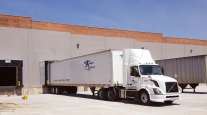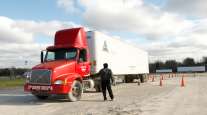Demand for Warehouses Rises in Houston Fueled by Online Shopping

The hottest niche in Houston's recovering real estate market is warehouses, evidence of the city's growing position as a distribution center for consumer goods in a rapidly evolving retail environment.
Vacancies in office and manufacturing space continue to edge upward locally, and Houston just posted its slowest quarterly growth in retail space in six quarters. But demand for warehouses is strong, fueled largely by population growth and consumers' growing preference for shopping online.
Commercial tenants in distribution and consumer goods leased more than 6.7 million square feet of space over the last two years in Houston, a 60% increase over the two years prior, real estate service firm JLL reported. Of 27 industrial facilities completed in Houston in the fourth quarter of 2016, 25 were warehouse and distribution spaces, according to market research by CBRE.
RELATED: Residents of Pennsylvania town voice objections to warehouse
Demand pushed rental rates up more than 20% between 2015 and 2016, to 59 cents per square foot for warehouse space. A decade ago, rates ran about 38 cents.
As Houston's distribution infrastructure bulks up, the region might eventually take on a bigger role nationally in moving goods from Port Houston throughout the heartland. More immediately, the jobs promised by projects underway help the city closer to a rebound from the prolonged energy slump.
"Warehouse distribution is definitely the shining star in industrial real estate," said Travis Land of NAI Partners.
The online-based retail model pioneered by Amazon has affected industrial real estate markets nationally. Warehouse distribution in particular is benefitting from the need to speed up deliveries.
"E-commerce has really been a game changer for industrial real estate. It's a structural change in demand," said Kevin Welsh, senior vice president with CBRE in New Jersey. "As more companies transact online, industrial real estate will be the major beneficiary."
As rental rates spike, institutional investors are putting more capital into automated warehouse projects, trusting they'll fetch high rent in years ahead, Welsh said. He called the demand "insatiable."
Traditional retailers also are expanding into e-commerce and new niche companies have begun selling everything from furniture to food online. But the U.S. leader is expanding its Houston footprint.
In the last year, Amazon announced three new projects, including two facilities of nearly 1 million square feet each: distribution centers in north Houston's Pinto Business Park and in the Katy area. It also leased about 100,000 square feet in Beltway Crossing.
Amazon's local holdings also include a sorting center and warehouse near Bush Intercontinental Airport and an Amazon Prime warehouse, off Hempstead Road, where common products from toilet paper to dog food can be rapidly distributed. There's also a so-called "last mile" warehouse near Gessner and Beltway 8, where bulkier items are processed before final delivery.
A robust e-commerce distribution network will eventually include dozens of small last-mile warehouses across the city. Amazon isn't there yet, and competitors haven't even started on that model. But they likely may.
"That's the way of the future," said Billy Gold, a senior vice president with CBRE in Houston. "I think you'll see other retailers follow."
"Just look at my street," he said. "There's a conga line of FedEx, UPS and mail trucks."
UPS ranks No. 1 and FedEx ranks No. 2 on the Transport Topics Top 100 list of the largest U.S. and Canadian for-hire carriers.
For now, most local warehouses are used for old-fashioned distribution of consumer goods to retail storefronts. Here, unlike elsewhere in the country, retail continues to expand along with the population. Experts say Houston may have grown large enough to warrant its own distribution network for consumer goods.
Dallas, with its landscape of supersized warehouses, has been the traditional hub, and it won't soon cease to be. Typically, consumer goods arrive through ports, including Port Houston, then travel by train to a Dallas warehouse, where containers are unpacked, loaded onto trucks and sent back to Houston and other destinations.
But with a population that grew healthily even during the oil slump, Houston is poised to claim a larger share of its own distribution.
"Houston has just gotten to be such a large market that [retailers] require a distribution facility in Houston, versus distributing 100% out of Dallas," said Justin Bennett, senior vice president at DCT Industrial in Houston.
Port's growing role
Over the past year, retailers including Ikea, Serta, Advanced Auto Parts, Wal-Mart, Home Depot, Office Max, Ford and Floor and Décor have built or leased large distribution centers in the Houston area. So has Conn's, which is closing stores across the states.
So far in 2017, FedEx has broken ground on an 800,000-square-foot distribution center in Cypress, and shipping logistics company DHL Supply Chain USA has announced it will build a 222,000-square-foot rail-served facility near Port Houston. Gulf Winds, a shipping logistics company, recently renewed its lease for a 303,000-square-foot warehouse in Greens Port Industrial Park.
As that network grows around the Bayou City, more big trucks will depart from local distribution centers, bound for stores in smaller communities across the region.
"Houston's becoming the hub of distribution for this area," said Jim Foreman, an executive director at Cushman and Wakefield.
That also has a lot to do with Port Houston, which has recently increased traffic in consumer goods in metal crates, aiming to compete with the nation's biggest distribution hubs on the east and west coasts.
Most commerce here begins at Port Houston, where thousands of products arrive daily by ship, from furniture to frozen meat to construction materials and more.
In Houston's southeast submarket dominated by the port, warehouses accounted for all of the area's more than 5 million-square-foot growth in industrial facilities since 2014, according to data from Transwestern. As of November 2016, 96% of square footage under construction was warehouse or distribution space.
The biggest driver of that growth is the boom in local production of plastic resins and the long-term expansion of the port's two container terminals. Both have implications for Houston.
'A third entry point'
The amped-up production of plastic resins came thanks to the shale boom, as natural gas from Texas formations dramatically cut the cost of producing plastics. At least five large plants that process natural gas for plastic resins are scheduled to open in 2017. Those facilities produce rail cars full of little plastic pellets, but they need off-site warehouses to package them into 50-pound bags and load them into shipping containers for export.
"Almost all the demand for rail-served warehouses in the area is being driven by resin packaging," said Jordan Frisby, an economic analyst with the port.
The expansion of container shipping also has led to more warehouse space. Last year's opening of a wider Panama Canal opened the shortcut to larger, more modern ships, including some bound for the docks in Houston.
Port Houston also has expanded its Barbours Cut and Bayport container shipping terminals, adding cranes and renovating wharves where ships loaded or unloaded more than 2 million large metal crates last year.
More warehouses have emerged around those spaces. They include some cold-storage facilities dealing in frozen meat and others used by third party logistics companies to unpack containers and load them on trucks bound for the retail warehouses around Houston.
Typically, most of those unloaded goods have stayed around the Houston area, said RD Tanner, senior director of real estate at the port. More and more, he added, they are traveling farther as Houston claims a growing share of distribution into the nation's interior.
"We're looking beyond being a regional port to being a third entry point into Middle America," Tanner said. "Our future is extremely bright in that regard."
Stephen Fuller, a professor of public policy at George Mason University who conducts research for the commercial real estate development association NAIOP, concurred, citing the confluence of shipping routes and rail lines that can reach as far as Canada without making costly ascents over mountains.
"Between the Appalachians and the Rockies," Fuller said, "you've got a pretty good swath of people."
Distributed by Tribune Content Agency, LLC




